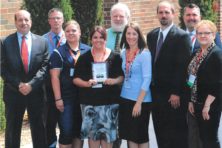Walloon: Door County’s Endangered Language
- Share
- Tweet
- Pin
- Share
Bau joo! Commai estau?
If you were at a church, grocery store or tavern in 1930s Brussels — the southern Door County community located within the largest Belgian-American settlement in the country — you likely would have heard this jovial greeting of “Hello! How are you?”
What appears to mimic French is actually the Belgian language of Walloon.
A Romance language (those derived from Vulgar Latin) that once dominated the Wallonia region of Belgium, its use has fallen markedly in the past two centuries — but not before a collection of Walloon speakers crossed the Atlantic in the 1850s in search of agricultural and economic prosperity. More than 15,000 Walloons found it in the forested lands of northeastern Wisconsin, where they established communities named in honor of their mother country — Brussels, Namur, Luxemburg and Rosiere, to name a few.
In the 160 years since, the communities’ rich cultural history of roadside chapels, an 1859 Marian apparition, and harvest festivals have been celebrated and documented through photographs and written records. But there is one element of the culture that was never written down: the Walloon language.
Today, members of the Belgian Heritage Center in Brussels estimate there are less than 80 residents in the area who still speak Walloon. The language faces a similar predicament in its home country 4,000 miles away, and in the small Northern France villages where it is spoken.
“This language is disappearing all over,” said Ann Jinkins, secretary of the Namur Belgian Heritage Foundation, which owns and operates the Belgian Heritage Center (BHC).
With the youngest Walloon speakers of this area in their 60s, the foundation has recently become a partner in an ambitious statewide project to document and preserve the language. They are doing that through the Wisconsin Walloon Preservation Project, launched in 2014 by former University of Wisconsin-Eau Claire language professor Kelly Biers.
Since the language has evolved differently on both sides of the Atlantic — and the only written version of Walloon was created in Belgium five decades after immigrants landed here — Biers and a team of UW-Eau Claire students have been tasked with creating the first written form of Walloon to exist in the U.S.
“The written form that they came up with [in Belgium in 1900] was made to be read by people who are usually speaking French so all of the words are written to look like French words and to make sense to French speakers,” Biers said. “If you were to show that to someone who usually speaks English, such as the people in Wisconsin, it doesn’t quite make as much sense.”
Despite the various dialects of Walloon that exist here and in Belgium, the reasons for its denigration are similar. After World War I, public schools in Belgium began providing French-speaking education to children. In the United States, students were taught in English. Eventually, in the 1940s, speaking Walloon at school in both countries was forbidden.
“Once we had to speak English, we spoke English,” said Theresa Alexander, BHC board member and fluent Walloon speaker. “There was no more Walloon.”
Students were sent home and told to return once they learned English. Even when they did, there was a social stigma attached to their native tongue, largely centered on the fact that in Walloon, th and h are not pronounced, leading this to become dis and that to become dat.
“Some of the students in my class were sloppy with the th’s and all of this stuff and you got a reputation as a dumb Belgian real fast,” said Sandy Orsted, BHC treasurer.
Walloon became the primary mode of conversation between Alexander and her mother, which proved important in maintaining her fluency. Today, small groups of Walloon speakers in the area gather to converse and maintain the language. They, and Alexander, are among the Walloon speakers contributing to the Wisconsin Walloon Preservation Project, which has been funded in part by UW-Eau Claire and through a Franklin Research Grant awarded by the American Philosophical Society. The preservation team has conducted interviews and audio recordings, and is now creating a writing system.
To create the written form, area Walloon speakers were given lists of common words and asked by Biers to write how they think the word should be written. After review, these lists will be compiled into a language booklet and published within the next three years.
That booklet, in turn, will be shared with the Walloon language community and at linguistic conferences across the nation.
“We want to contribute to the world’s knowledge of languages but we also want to do something that is useful for the language community that we’re working with,” Biers said. “That’s our priority. We want to tell the story of Walloon to more people because so many people in Wisconsin don’t know that it’s there and it’s such an interesting part of the history and heritage of Wisconsin.”
Biers admits the pressures of creating a written language are great, especially since the project’s leaders are spread out across the country (he now teaches at the University of North Carolina at Asheville) and those who speak the language are fewer every year. But it’s a pressure that comes secondary to his biggest mission.
“Every time you lose a language, we lose a little bit of history and a little bit of cultural information,” Biers said. “That’s why we’re interested in this project and why we have continued to work with this community. We want to make sure that they have some tie to that language in the future.”



